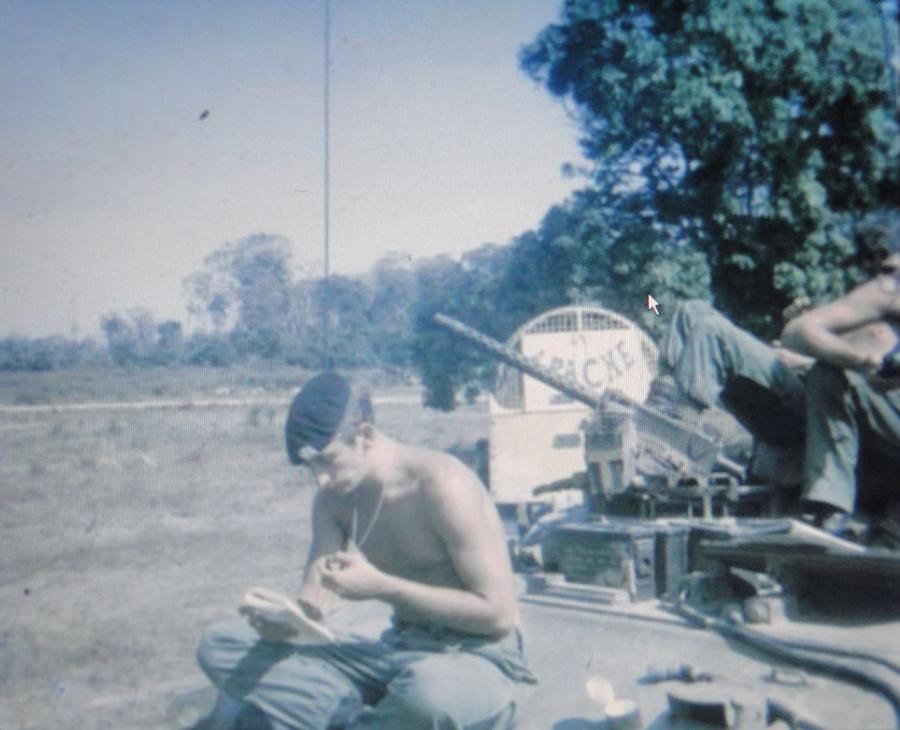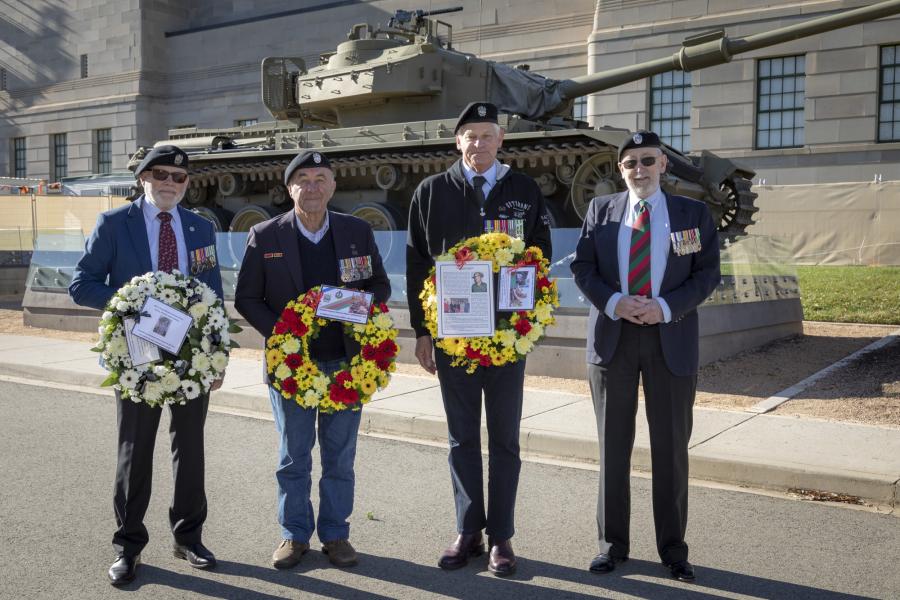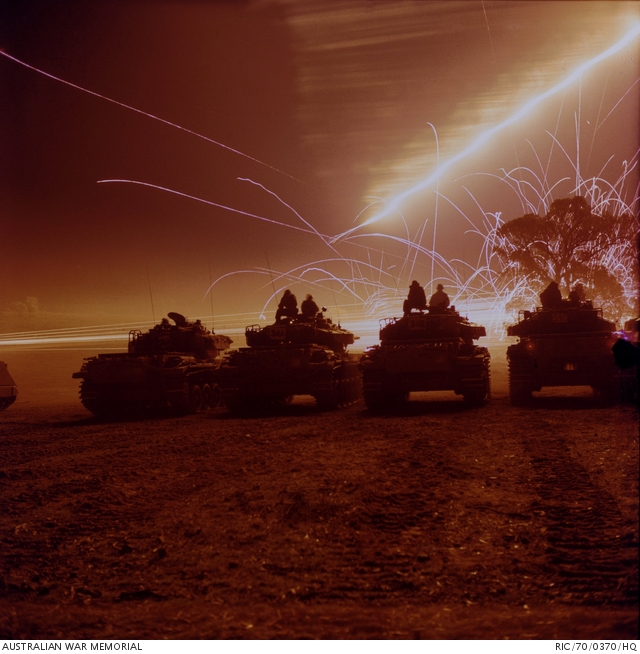'A tank in action is not a piece of engineering, it is the beating heart of its crew'

Bruce Cameron MC in Vietnam. Photo: Courtesy Bruce Cameron
When Bruce Cameron looks at the Centurion tank outside the Australian War Memorial in Canberra, the memories come flooding back.
To Bruce, it’s not just a piece of engineering; it’s the beating heart of its crew, a poignant reminder of events more than 50 years ago.
In 1971, Lieutenant Colonel Bruce Cameron MC was a young Second Lieutenant, serving as a troop commander with C Squadron, 1st Armoured Regiment, in Vietnam.
He was only 22 years old when he commanded the last troop of tanks in action in Vietnam and was awarded the Military Cross for his courage and leadership during the war.
During the battle of Long Khanh, he launched an attack against a heavily defended, cleverly concealed, bunker complex; the tanks forcing the enemy’s withdrawal from the forward bunkers and contributing greatly to the defeat of the entire enemy force.
He also risked his life to save his driver, who had been severely wounded, and was in danger of being killed, during Operation Hermit Park, a joint infantry/armoured clearance operation conducted in dense jungle near the De Courtenay Rubber Plantation in Phuoc Tuy Province.
The tank he commanded that day is the one that is on display outside the Memorial.
“It’s good to have the tank here,” he said.
“But it’s not about how heavy they are, or how fast they go, or how much ammunition they have: it’s the stories they serve to tell that matter.”
Group portrait of C Squadron, 1 Armoured Regiment, taken at Puckapunyal in 1970.
The son of a Second World War veteran, Bruce went on to serve in the Australian Regular Army for 19 years.
He was born in Melbourne in December 1948 and graduated from the Officer Cadet School at Portsea in June 1969.
“My father was a Second World War veteran, and a career soldier,” he said.
“But when I was growing up, I didn’t think too much about what I wanted to do until I left school at 16.
“I had a scholarship to go to Duntroon, but when I got to Duntroon, it wasn’t what I expected, so I went to England, where my father was posted at the time, and joined the Bank of New South Wales.
“While I was over there, I joined the Territorial Army – the British Army Reserve – and realised I quite enjoyed the Army, so I applied for Portsea and got in.”
Inspired by an armoured corps instructor at Portsea, Bruce joined the Royal Australian Armoured Corps. He was posted to C Squadron, 1st Armoured Regiment, in January 1970, and arrived in Vietnam the following year, on 21 January 1971.
“I flew in on a 707, and the heat and the humidity really struck you when you landed,” he said.
“We had tried to duplicate the conditions in Vietnam as much as possible during our training, but nothing can prepare you for the smells and the humidity and the dust and everything else.”
Crews from C Squadron, 1st Armoured Regiment, engage targets during night firing training at Puckapunyal. The Squadron departed for Vietnam in December 1970.
More than 50 years later, Bruce still remembers it as if it were yesterday.
“I remember going into a tent that I was sharing with a sergeant,” he said.
“I unpacked my bags, and I felt a need to go and look at my tank and check it out.
“I was really surprised when I saw it for the first time.
“There were grenades in the turret, and I thought, ‘Why have we got grenades? What use will we have for grenades?’
“I was soon to realise, of course, but in training you never occupied a fully bombed-up tank, which was ready to go at a moment’s notice with all its ammunition and weapons fully prepared so it was a big shock.”
Bruce remembers there was little or no handover when they arrived.
“In many cases, the people we were taking over from said goodbye to us as they got on the plane to fly out, so there was no handover of any sort,” he said.
“It was pretty much straight into things and getting to know the lie of the land, which is pretty important for a tank crew. With the experience of the troop, you sort of know you shouldn’t go over there because it will be boggy or whatever, and gradually you develop that knowledge and experience yourself.”
The 53-tonne Centurion tanks were not only involved in intense fighting with infantry and artillery to capture enemy defences and defeat attacks. They also fought their own battles against enemy mines, ambushes, and an unforgiving terrain and climate.
“They were late in sending tanks to Vietnam because they thought they wouldn’t be able to operate successfully,” Bruce said. “They thought they’d sink in the paddy fields and that they wouldn’t be able to get through the jungle … but they became an indispensable part of Australian combat operations, so much so, that their subsequent withdrawal was as controversial as their deployment.”
The 1st Armoured Regiment’s tanks worked closely with the Australian infantry and the APCs of 3rd Cavalry Regiment on operations throughout Phuoc Tuy and neighbouring provinces. They provided fire support for infantry operations, were used to directly attack enemy positions, and helped defend the Fire Support Bases.
“In our training in Australia, we learnt that tanks always operate with infantry, and that they’re very vulnerable if they didn’t have infantry with them, but we soon learnt that in the circumstances at the time we could also operate effectively by ourselves,” he said.
“We could operate as an independent entity quite safely, and dominate and control an area, and look for information and things like that.
“But we were particularly vulnerable at night, and we had to be very careful.
“I remember on one occasion, the sentry was looking through the night-viewing device, a very early generation night-vision device called a Starlight Scope.
“It’s very basic, first-generation equipment, and the sentry could see four legs.
“He couldn’t tell whether it was the enemy because he couldn’t see them properly because of the vegetation and all the foliage higher up.
“It was after curfew, but it could have been farmers returning late, so we counted down, and when I said, ‘Three, two, one, now,’ we all turned on our searchlights.
“It was the biggest buck deer that anybody had ever seen. It had these antlers on it which were just incredible. And what the sentry had seen through the Starlight Scope was its four legs.
“The deer was as surprised as we were, but it made me realise that if the deer hadn’t picked up on the fact there was a tank troop there, then quite likely, the enemy wouldn’t either.
“You’d think with the tank smell, and the noise they make when they’re cooling down and engine parts are contracting, you wouldn’t be able to hide them. But we learnt how to ambush silently, and we developed our capability enough to ensure we weren’t making a lot of noise, and we weren’t giving the enemy any warning that we were there.
“You’ve also got fireflies buzzing around in front of you, which is one of the things that takes a bit of time to get used to.
“I hadn’t known about fireflies before, and sure enough you would see these lights, and think, ‘Are they torches? Or what are they?’
“And, of course, the Vietnamese used to gather these fireflies together and use them as illumination so sentries had this tremendous tension all the time.”
Fireflies were not the only insects the tank crews had to worry about.
“I remember one of my troop sergeants knocked a large wasps’ nest down from a tree, and it fell on top of him,” Bruce said.
“These wasps all swarmed around him, and he was stung so many times around the face and neck, he had to be ‘dusted off’ and medevaced out.
“Ants would get knocked down too, and we also got the odd snake, and that sort of thing, which certainly makes life interesting.
“We had to carry large containers of calamine lotion with us for when we were going through the bamboo.
“Bamboo has these little flakes, which are like itching powder, and once it comes down on top of you, it’s so uncomfortable that you rip your skin off.”
He also remembers the gunners, trying to survive the heat inside the turret, while identifying designated targets; the operators trying to maintain communications, while keeping the guns loaded; the drivers, trying to see their way forward, while keeping their heads down; and the commanders, trying to locate enemy positions, while directing their drivers and giving fire orders.
The mechanics also had to overcome extraordinary challenges to maintain the 22-year-old tanks, and the field engineers risked their lives to protect the tanks and their crews against mines.
“Everyone was very alert to the possibility of mines and booby traps, and mines were always at the forefront of everyone’s minds,” he said.
“There was always the possibility of running over a mine; that was the greatest threat to us, I think, rather than being ambushed.
“Normally we were too big to be ambushed and the enemy would let us go by because they wanted a softer target.
“But the mine was a way they could deal with us without exposing themselves to our weapons.
“The mine incidents we had in Vietnam were phenomenal, just the amount of effort the enemy went to, to create mines that would knock out a tank, and crack or twist the hull.
“You’ve got to do a lot to knock out a 53-tonne tank.
“And that’s when they started offsetting the mines. They’d put the pressure plate under the track, and put the explosive in the centre, so that the mine would go up directly underneath the tank.
“And then they got even cleverer. They connected an anti-tank rocket warhead – and in some cases, more than one – to the pressure switch so that the warhead fired through the bottom of the tank.
“In the Centurion tank, the ammunition is laid horizontally on the floor, just above the hull armour, so when the warhead went through, it ignited the ammunition, and that was incredibly effective for them.
“I know of one particular engineer, who was particularly good, and one day he slammed the driver on the helmet and called out stop. He’d seen there was a wire poking out of a tank track ahead, and the driver had to back up to allow him to examine it.
“That’s how close the crew were to running over this switch. It had been set into previous tank tracks, which had then been remoulded into shape.
“The explosive which was uncovered was offset and directly under the tank, and it was enormous.
“It was amazing the engineer happened to notice it.”

Bruce Cameron MC, pictured far right, with Tony Dickinson, Stan Hanuszewicz and Kim Bayly in front of the Centurion tank 5 Bravo at the Memorial.
Today, Bruce wears his black beret with pride.
“A tank is more than just an armoured vehicle,” he said.
“And in terms of the tanks, the crew is the crew, in both word and in deed, and you’re relying on each other.
“You could never really relax … and it wasn’t just one incident, it was every day.
“The tanks were constantly on call … and it’s not as if the tank crews were in some sort of cocoon in which they were protected.
“The opposite was the case, and they knew full well they were vulnerable.
“The only weapons the tanks were immune to were pistols and small arms; everything else – anti-tank rockets, recoilless rifles, mines, satchel charges, heavy machine guns – they could all penetrate the vehicle, while satchel charges and snipers were also threats to the crew.
“And the bravery of the crew was in knowing this, they still went forward.”
Read about Bruce Cameron's experiences during Operation Overlord and Operation Hermit Park.






